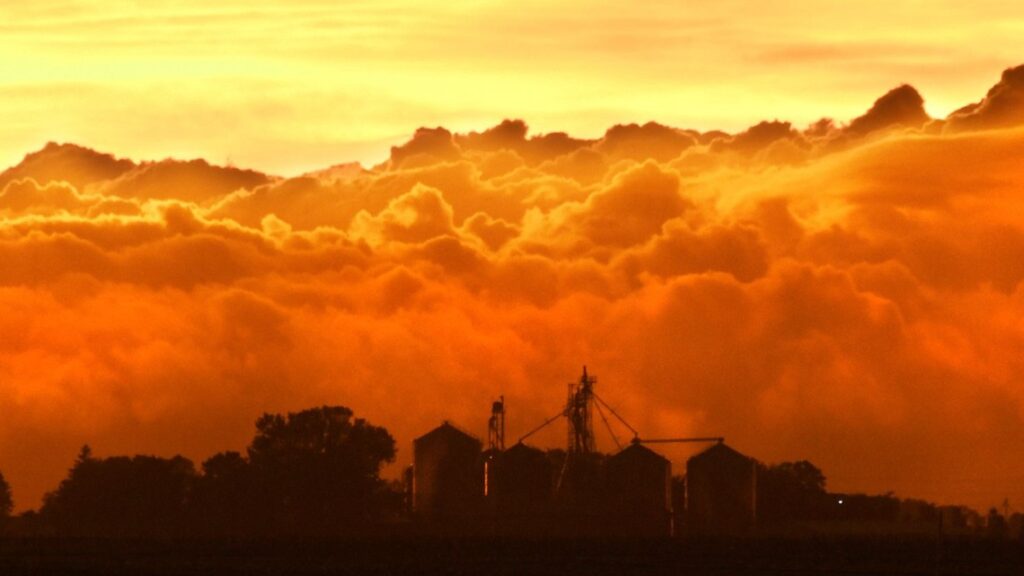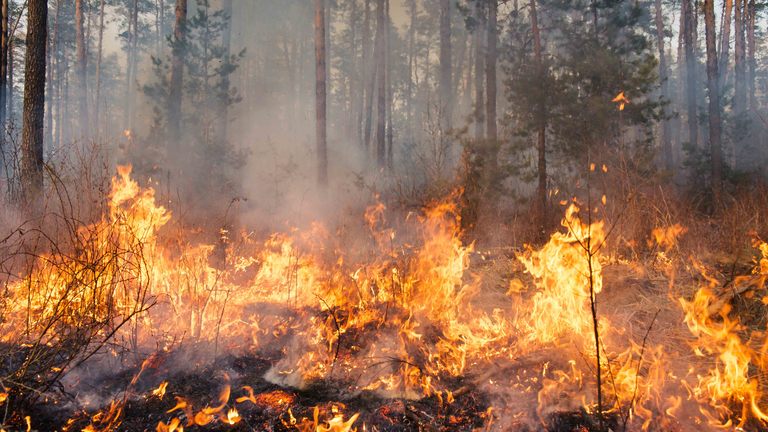Have you ever looked up at the sky glowing bright orange and wondered what makes it look so beautiful? Whether it is during a sunset or because of things like wildfires, there’s real science behind this amazing sight.
The sky turns orange during wildfires because the smoke particles scatter shorter wavelengths of light, like blue and green, leaving the longer red and orange wavelengths more visible.
In this article, we will break down why the sky turns orange in a way that is easy to understand. We will cover both natural reasons and those linked to environmental issues.
Why Does the Sky Turn Orange? Understanding Natural and Environmental Causes:
The changing colors of the sky are something that has always fascinated people. Whether it is a bright blue sky or a breathtaking orange sunset, it often makes us wonder why the sky looks the way it does.

One of the most eye-catching moments is when the sky turns orange, which can happen during sunsets or due to things like wildfires.
In this article, we will explore the science behind this beautiful phenomenon, the environmental and health effects, and what it might mean in the bigger picture, especially with climate change in mind.
How Light Scattering Creates an Orange Sky?
Have you ever noticed the sky turning a beautiful orange during sunrise or sunset? To understand this, we need to look at how sunlight interacts with our atmosphere. Sunlight is made up of different colors, and as it passes through the air, it gets scattered by tiny particles and molecules.
This scattering happens more with shorter colors like blue and violet, which is why the sky looks blue when the sun is high in the sky. But when the sun is near the horizon, like during sunrise or sunset, its light travels through a thicker part of the atmosphere.
This longer path causes even more scattering of those shorter colors, letting the longer colors—like red and orange—shine through. That is what creates those stunning warm hues in the sky! Is not nature amazing?
Read Also: VandyWorks
Why Do We See Orange During Sunsets?
Have you ever noticed how beautiful the sky looks during sunsets? It often turns a lovely orange color, especially when the sun is just above the horizon.
This happens because, at that time, the sun’s light has to travel through more of the Earth’s atmosphere than when it is directly overhead. As it travels, the shorter blue and violet wavelengths get scattered away, leaving us with the warmer reds, oranges, and yellows.
Things like dust, water vapor, and pollution can also help make those orange and red colors even more vibrant. So, while this colorful display happens every day, it becomes extra stunning when there are particles in the air, like during wildfires. It is nature’s way of reminding us how beautiful our world can be!
Wildfires and Their Effect on Orange Skies:
Lately, we have seen more wildfires happening, and they are getting worse, mostly because of climate change. These fires send out a lot of smoke and tiny particles into the air, which can really change how the sky looks.

When the air is filled with smoke from wildfires, it can scatter light in such a way that the sky appears orange or even red, even in the middle of the day.
The particles in the smoke are really good at scattering shorter wavelengths of light, like blue and green, so what we end up seeing more of are the longer wavelengths, like red and orange. It is quite a sight, but it also reminds us of the serious impact wildfires can have on our environment.
The Health Risks of Wildfire Smoke:
An orange sky during a wildfire might look amazing, but it is actually a sign of serious danger. The smoke that creates that striking color has tiny particles called PM2.5, which can be really harmful to our health.
These small particles are so tiny that we can breathe them deep into our lungs, where they can cause breathing problems, make asthma worse, and even lead to long-term issues like heart disease.
Areas that often deal with wildfires, like the western United States, are especially at risk from these tiny particles. People living in these regions might find themselves facing days or even weeks of bad air quality, with the sky staying that hazy orange for a long time. It is a reminder to be cautious and take care of our health when wildfires are nearby.
The Effect of Climate Change on Wildfires:
Climate change is really affecting how often and how intensely wildfires happen around the globe. Warmer temperatures, longer periods of drought, and changes in plant life are all creating conditions that make wildfires more likely.
Recent studies show that the amount of land burned by wildfires in the western United States has shot up by over 500% since the 1970s.
This dramatic increase is closely tied to higher temperatures and longer dry spells, both of which are results of global climate change. It is a scary reminder of how our changing climate is impacting nature and our communities.
Read Also: Hair Botox
Wildfires and Carbon Emissions – A Harmful Cycle!
Wildfires do more than just turn the sky orange during smoke events; they also send a lot of carbon dioxide into the air, which worsens climate change. This creates a harmful cycle: as fires become more frequent, they release more carbon emissions, which speeds up global warming.
On top of that, wildfires destroy forests that help absorb CO2 from the atmosphere. When these forests burn down, they can no longer soak up carbon, making the problem even worse. It is like losing a friend who always helped you out—now, we have less support in the fight against climate change.
The Bigger Picture of Wildfires on Nature:
Wildfires do not just harm the air we breathe and affect the climate; they can also really shake up the environment. These fires can destroy entire ecosystems, leading to the loss of plants and animals, and throw local food chains out of balance.

It is heartbreaking to see how a single wildfire can change the landscape and impact wildlife. It is a reminder of how interconnected everything is in nature and how much we need to protect it.
Wildfires and Biodiversity:
In places where wildfires are happening more often, the variety of living things, known as biodiversity, is in danger. Many animals and plants are not built to handle frequent fires, and their homes might be changed forever or even destroyed. When plants disappear, it can create problems for the animals that depend on them for food and shelter.
Wildfires also hurt the soil and change how water moves through the environment. After a fire, the ground can lose its richness, making it tough for new plants to grow.
Plus, without plants to hold it in place, the soil can easily wash away or blow away, leading to even more issues like erosion. It is a tough cycle that shows how interconnected everything is in nature.
Policies and Actions to Help Prevent Wildfires:
With wildfires becoming more common and intense, many governments and organizations are stepping up to find ways to lessen their effects. Some of the best strategies include better forest management, controlled burns, and stricter land-use rules.
Controlled Burns and Forest Management:
One effective way to lower the risk of big, uncontrollable wildfires is by using controlled burns. These are small, planned fires set in a safe way to clear out extra plants and brush.
By doing this regularly, land managers can prevent dry materials from piling up, which can lead to huge, destructive fires later on.
Another important strategy is forest management. This includes thinning out crowded forests, taking out dead trees, and planting native species that are tougher against fire.
Better land-use policies, like limiting building in areas prone to wildfires, can also help keep communities safe from the growing threat of these fires.
Read Also: Kevin McCarthy Wife
The Astrophysical Connection – Light Scattering Beyond Earth:
Light scattering is not just something we see here on Earth; it happens in space too! Astronomers often face challenges from interstellar dust, which can scatter light and make it hard to spot distant stars and galaxies.
How Astronomers See Through Cosmic Dust?
Recently, astronomers have come up with some cool tools and techniques to help them see past this cosmic dust. One of the most exciting advancements is the use of infrared telescopes.

These telescopes can detect light at longer wavelengths, which can more easily pass through the dust than the visible light we see with our eyes.
Thanks to these innovative technologies, astronomers have made some amazing discoveries, like finding planets around distant stars and learning about the early universe. Even though dust can make things tricky, scientists are determined to explore and expand our understanding of what’s out there in space!
FAQs:
Are orange skies dangerous?
An orange sky during a wildfire often signals poor air quality, which can be harmful to your health. The smoke contains fine particles (PM2.5) that can lead to respiratory issues.
How does climate change affect the frequency of wildfires?
Climate change is causing warmer temperatures and longer dry seasons, both of which increase the likelihood and intensity of wildfires.
Can air pollution affect the color of the sky?
Yes, air pollution can alter the color of the sky. Pollutants can create additional particles in the air that scatter light, often resulting in a more orange or reddish sky, especially during sunrise and sunset. This phenomenon is similar to what occurs during wildfires.
Is an orange sky a sign of bad weather?
An orange sky can sometimes indicate changes in the weather. For example, an orange hue might appear when a weather front is approaching, often seen in the morning before a storm. However, it is not always a definitive indicator of bad weather.
Does the orange color in the sky have any health implications?
While the orange sky itself is not harmful, it often indicates the presence of smoke or pollution in the air, which can pose health risks. Fine particulate matter (PM2.5) from smoke can lead to respiratory problems and other health issues, especially for vulnerable populations.
Conclusion – Why an Orange Sky Matters for Our Future:
Seeing an orange sky, whether at sunset or because of a wildfire, is a beautiful yet powerful reminder of how light interacts with our atmosphere. These stunning sights are not just pretty; they also tell us important things about our environment.
As climate change gets worse, we are likely to see more wildfires, leading to even more orange skies.
Read Also:
Feli Fayer
Https://Noticviralweb.Blogspot.Com/2024/04/Crm.Html
Views-source:https://roobx4uuu.blogspot.com
